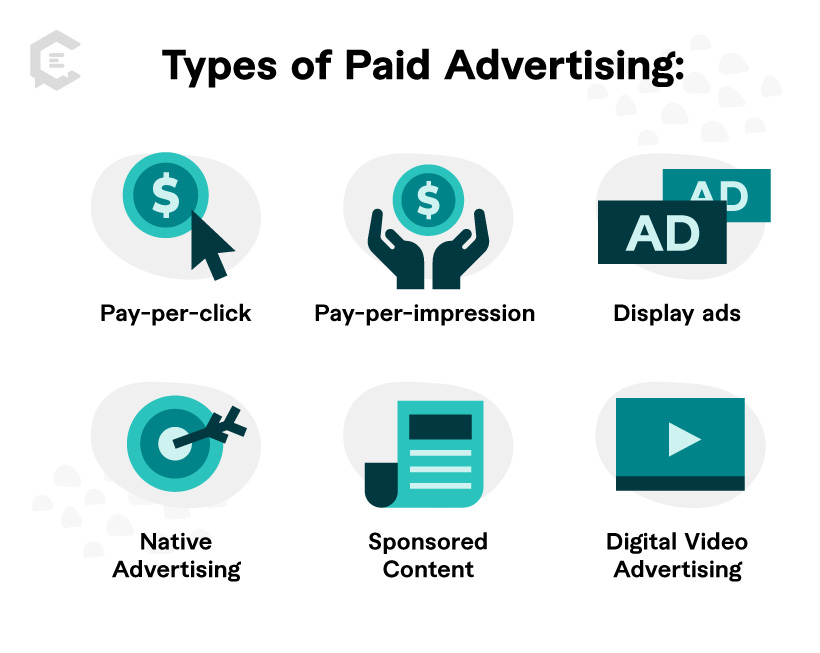
Paid advertising is a marketing model where brands pay to show ads to their target audiences.
Paid advertisements mostly work on an auction system. Advertisers bid against each other for ad space on platforms like Google Ads or Meta ads. The platforms’ algorithms determine whose ads are shown and when.
Every ad platform has a unique bidding algorithm. But most consider factors such as the bid amount, ad quality, and user engagement to determine which ads are chosen.
Benefits of Paid Advertising
Paid ads offer benefits to small and large businesses, including:
Targeted Reach:
Paid ads let you target specific groups based on age, location, interests, and more. This ensures your ads are seen by the right people, boosting effectiveness.
Immediate Results:
Unlike organic strategies, paid ads can drive traffic to your site instantly. This helps quickly increase visibility and attract potential customers.
Measurable Performance:
Detailed analytics from platforms like Google Ads allow you to track performance. This helps in making informed decisions and optimizing campaigns.
Budget Control:
You can set and control your budget easily, making paid advertising flexible and cost-effective. You only pay when someone clicks on your ad, ensuring efficient spending.
Types of Paid Ads

Here are more detailed descriptions of common types of paid advertising:
1.Search Engine Advertising (PPC):
Google Ads:
Businesses bid on specific keywords, and their ads appear in search engine results when those keywords are used. The pay-per-click (PPC) model means you only pay when someone clicks on your ad, making it a cost-effective way to reach potential customers actively searching for related products or services.
Bing Ads:
Similar to Google Ads, Bing Ads allows you to reach a different segment of the search engine market. It offers unique features like LinkedIn profile targeting, which can be particularly useful for B2B campaigns.
2.Social Media Advertising:
Facebook Ads:
Leverage the vast user base of Facebook to target ads based on detailed user demographics, interests, and behaviours. Facebook Ads can appear in users’ newsfeeds, stories, or as sponsored posts, providing a range of formats to engage users.
Instagram Ads:
Integrated with Facebook’s ad platform, Instagram Ads focus on highly visual content, appearing in users’ feeds and stories. This platform is ideal for brands looking to reach a younger, visually-oriented audience.
LinkedIn Ads:
Target professionals by industry, job title, company size, and other professional criteria. LinkedIn Ads are effective for B2B marketing, promoting job listings, professional services, or industry-specific content.
3.Display Advertising:
Banner Ads:
These are graphical ads that appear on various websites, typically in designated ad spaces like headers, footers, or sidebars. They can be static or animated and are designed to attract attention and drive traffic to your site.
Native Ads:
These ads are designed to blend seamlessly with the content of the website they appear on, providing a more natural user experience. Native ads often appear as recommended content or in-feed ads, making them less intrusive and more engaging for users.
4.Video Advertising:
YouTube Ads:
Video ads that play before (pre-roll), during (mid-roll), or after (post-roll) YouTube videos. These ads can be skippable or non-skippable and are effective for engaging viewers with compelling visual and audio content.
In-Stream Ads:
Short video ads that appear within streaming content on platforms like Hulu, network websites, or other streaming services. These ads are integrated into the viewing experience, ensuring they are seen by a captive audience.
These types of paid advertising offer versatile ways to reach and engage your target audience across various platforms and formats, each with its unique strengths and best use cases.
New Trends in Paid Ads for 2024
1.AI-Powered Advertising:
Automation:
AI has helped in improving the ad management where AI selects keywords, bids for them, and defines the target market. This assists the advertisers in saving time as well as increasing the performance.
Personalization:
Utilizing AI features is the option to reach vast amounts of data to produce ads that may appeal deeply to the interests of the specific users thereby gaining higher conversion rates.
2.Dominance of Video Ads:
Short-Form Videos:
Social applications like TikTok and Instagram Reels are famous due to brief compelling video content.
Live Streaming:
Real-time video ads across YouTube and Facebook are increasing as a method that allows interacting with viewers and developing a sense of the event’s uniqueness.
3.Enhanced Targeting Options:
Behavioural Targeting:
The increased use of the internet brings about more data that the advertisers can use to reach out to the plane users through behavioural data like previous purchases.
4.Interactive Ads:
Engagement:
These ads capture the user’s attention and compel him to click on the content to have an interaction with the content, thus making the ad a memorable one for the user.
Augmented Reality (AR):
AR ads enable people to preview the products; for instance, how a piece of furniture will look in the house or how a particular outfit will look on them. It can also increase the user’s interaction and sales through the use of this interactive design.
They show that paid advertising is not stagnant and that businesspeople must update them concerning the latest trends to develop better and engaging advertising campaigns in 2024.
Stay Legal and Ethical in Digital Ads
Being legally and ethically correct in the digital advertising sector becomes very essential for building customer-company trust and to avoid litigation. Transparency is key: it is also important that the content that one posts as a blogger should contain the word ‘advertorial’ when one is posting sponsored content or paid promotions to ensure that the audience identified it as an advert. Comply with the privacy laws including GDPR and CCPA and ensure that users give their consent before providing information.
Continuous with your ads’ credibility and do not portray any wrong information about your products or services. If you follow these tips to the latter, you’re way ahead in generating high-performing and believable digital ads.
Conclusion
Perhaps the most effective way of using paid advertising is that it strategically addresses the needs of reaching the target market, gaining instant access to consumers, and being able to reliably assess the outcomes of a campaign. They can use they dispel channels Google AdWords and Pay per click advertising and other social sites like Face book and many other sites. Nevertheless, there are great expectations that web users and proprietors will continue to adhere to honesty, user’s privacy, and adherence to the principles of non-discriminatory advertisements. The essence of advertising in the digital platform is likely to remain dynamic as we progress to the future; therefore, it will be pivotal for one to be conversant with trends and the most ethical ways to sell products and services as a marketer.





